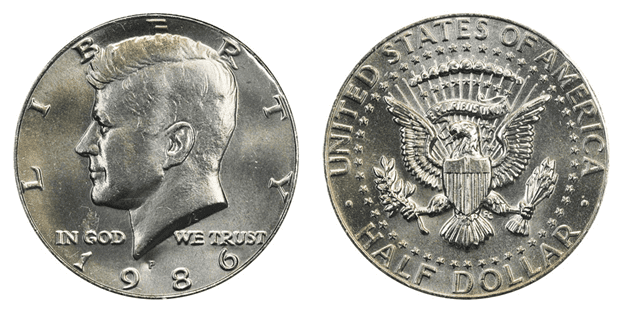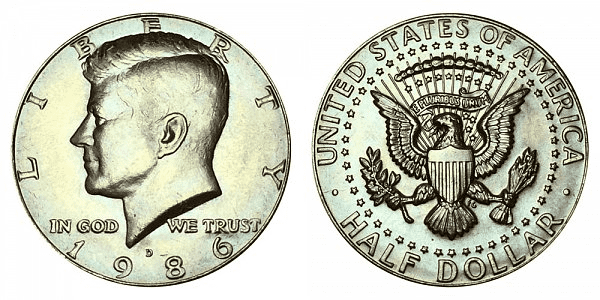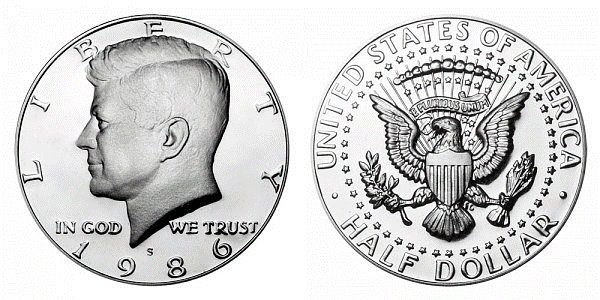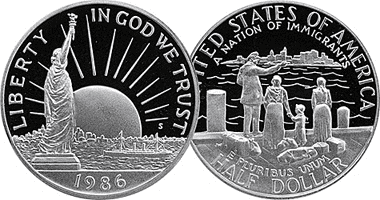What Is the 1986 Half Dollar Made Of?
Both collectors and non-collectors save the Kennedy Half Dollar, one of the most well-known and treasured coins in memory of one of the most admired US presidents—John F. Kennedy.
The US Mint chose sculptors Gilroy Roberts and Frank Gasparro to finish the piece when Congress agreed to develop a new half-dollar design to honour John F. Kennedy. The finished piece of art was straightforward and focused on paying tribute to Kennedy and the country he served. The first Kennedy half dollar was minted in 1964, and it is still in circulation today.
The obverse of the coin has a bust of John F. Kennedy looking to the left. At the top of the coin is engraved “LIBERTY,” and at the base of Kennedy’s neck is written, “IN GOD WE TRUST.” The mintage date is centred at the bottom of the obverse.
The American bald eagle’s coat of arms can be seen on its breast, and its wings are spread widely. The olive branch and a number of arrows are in the eagle’s talons. The words United States of America are centred at the top of the coin, and half dollar is centred at the bottom.
Half dollars were made up of 91.67% copper and 8.33% nickel in 1986. The coin’s edge measures 30.6 mm in diameter, 2.15 mm thick, and has 150 reeds. The coin weighs 11.34 g and has a reeded edge.
The meltdown at the Chernobyl nuclear power facility turned 1986 into a catastrophe that changed history forever. Both the tragic Challenger shuttle accident and Halley’s comet’s close encounter with Earth happened in 1986.
1986 Half Dollar Varieties
1986 P Kennedy Half Dollar
Year: 1986
Face Value: $0.50
Composition: 8.33% nickel and 91.67% copper
Total Weight: 11.34 g
Diameter: 30.6 mm
Thickness: 2.15 mm
Edge: 150 Reeds
Minted in: Philadelphia
Quantity Minted: 13,107,633

1986 D Kennedy Half Dollar
Year: 1986
Face Value: $0.50
Composition: 8.33% nickel and 91.67% copper
Total Weight: 11.34 g
Diameter: 30.6 mm
Thickness: 2.15 mm
Edge: 150 Reeds
Minted in: Denver
Quantity Minted: 15,336,145

1986-S Proof Kennedy Half Dollar
Year: 1986
Face Value: $0.50
Composition: 8.33% nickel and 91.67% copper
Total Weight: 11.34 g
Diameter: 30.6 mm
Thickness: 2.15 mm
Edge: 150 Reeds
Minted in: San Francisco
Quantity Minted: 3,010,497

US Statue of Liberty Commemorative Half Dollar 1986

The US government discovered that it could sell attractive commemorative coins for considerably more than they were worth and still make a tidy profit around 1986. The face value of this coin is 50 cents, although the mint only made a profit of roughly $7 per piece.
The sentimental worth of these coins, which feature a lovely design, may be very high. They would be worth a lot if they were made of silver. These coins, however, are constructed of copper and nickel. Uncirculated coins currently sell for an average retail price of $1 to $3. A proof copy, like the one in our image, might cost between $5 and $7.
List Of 1986 Half Dollar Errors
There are no nationally recognized Kennedy Half Dollar errors, meaning the errors seen in coins minted in this year are regarded on a coin-by-coin basis.
How Much Is 1986 Half Dollar Worth Today?
Due to the absence of precious metal, Kennedy half dollars made between 1971 and 2014 have a substantially lower melt value than their face value, which is only $0.1003423. This means that the 1986 Kennedy Half Dollar’s value is seen in pristine condition and errors. High-grade 1986 Half Dollars can be worth around $5.70-6.65, making them suitable for entry-level collectors.
| Coin | Condition | Grade | Mintage | Value |
| 1986 D Kennedy Half Dollar | Uncirculated | MS-63 | 15,336,145 | $5.70 |
| 1986 P Kennedy Half Dollar | Uncirculated | MS-63 | 13,107,633 | $6.65 |
| 1986 S Kennedy Half Dollar | Uncirculated | PR-65 | 3,010,497 | $6.65 |
How Does The Grading System Work?
The Sheldon Scale is used by numismatists to provide a numerical value to coins. The Sheldon Scale goes from poor (P-1) to perfect mint state (P-1) (MS-70). Coins were originally evaluated using words to reflect their condition (Good, Fair, Excellent, Etc.). Unfortunately, coin collectors and dealers had different ideas about what each of these terms represent.
Professional numismatists joined together in the 1970s and established CoinGrading standards. These numismatists now assign grades at key places on the seventy-point scale, using the most regularly utilized numeric points in conjunction with the original adjective grade. The following are the most common coin grades:
-
-
- (P-1) Poor – Indistinguishable and probably damaged; if used, must have a date and mintmark; otherwise, rather battered.
- (FR-2) Fair – Nearly smooth, but without the damage that a coin graded Poor often possesses. The coin must have enough detail to be identified.
- (G-4) Fair – Inscriptions have merged into the rims in some areas, and important elements have been mostly erased.
- (VG-8) Very Good- A little weathered, but all of the primary design elements are visible, albeit faintly. There is little if any, central detail left.
- (F-12) Good – The item is very worn, yet the wear is even, and the overall design details stand out clearly. Rims are almost completely isolated from the field.
- (VF-20) Very Fine – Moderately weathered, with some finer features still visible. The motto or all letters of LIBERTY are readable. Both sides of the coin have entire rims that are separated from the field.
- (EF-40) Extremely Fine – Gently used; all gadgets are visible, and the most important ones are bold. The finer details are bold and clear, however, light wear may be seen.
- (AU-50) Uncirculated – Slight evidence of wear on the coin’s design’s high points; may have contact marks; eye appeal should be adequate.
- (AU-58) Uncirculated Choice – Slight traces of wear, no severe contact marks, almost full mint shine, and great eye appeal.
- (MS-60) Mint State Basal – Strictly uncirculated; no indication of wear on the coin’s highest points, but an unsightly coin with reduced luster, visible contact marks, hairlines, and other flaws.
- (MS-63) Mint State Acceptable – Uncirculated, but with contact scratches and nicks, little reduced shine, but otherwise appealing appearance. The strike is weak to average.
- (MS-65) Mint State Choice – Uncirculated with great mint shine, very little contact blemishes, and exceptional eye appeal. The strike is unusually severe.
- (MS-68) Mint State Premium Quality – Uncirculated with superb luster, no obvious contact marks to the naked eye, and exceptional eye appeal. The strike is quick and appealing.
- (MS-69) Almost Perfect Mint State – Uncirculated with perfect brilliance, a sharp and appealing strike, and extremely good eye appeal. A near-perfect coin with minor imperfections in the planchet, strike, and contact markings (seen only under 8x magnification).
- (MS-70) Mint State Perfect – Under 8x magnification, there are no tiny imperfections discernible; the strike is crisp, and the coin is perfectly centered on a beautiful planchet. Rarely seen on a coin, this coin is bright and whole, with original luster and exceptional eye appeal.
-
Where To Buy Or Sell 1986 Half Dollar?
Due to their (usually) low worth, 1986 half dollars can be purchased and sold with some degree of assurance on online auction sites like eBay and Etsy. Naturally, you should always make sure to look for any uncommon flaws before you sell any 1986 half dollars, since these coins must first be authenticated and graded by a company like PGCS in order to be offered for sale at auction or to a specialised dealer.
FAQs
Is the 1986 Liberty Half Dollar silver?
The 1986 Kennedy Half Dollars are made up of 91.67% copper and 8.33% nickel, thus they don’t include any silver.
What’s the rarest 50 cent piece?
The most uncommon half-dollar coin, excluding overdates, proofs, and unusual variants, is the 1873-S without arrows. It is believed that none of those coins survived. The 1796 and 1797 half dollars are the rarest coins remaining in circulation. From 1878 through 1890, seated liberty half dollars had some low mintages and were typically hard to come by.
What year half dollars are pure silver?
Kennedy half-dollars from 1964 are made of 90% silver, while those from 1965-70 are 40% silver. For the bicentennial, some 1976S coins were minted in 40% silver, and from 1992 onwards, there were special-proof coins minted in silver each year.
